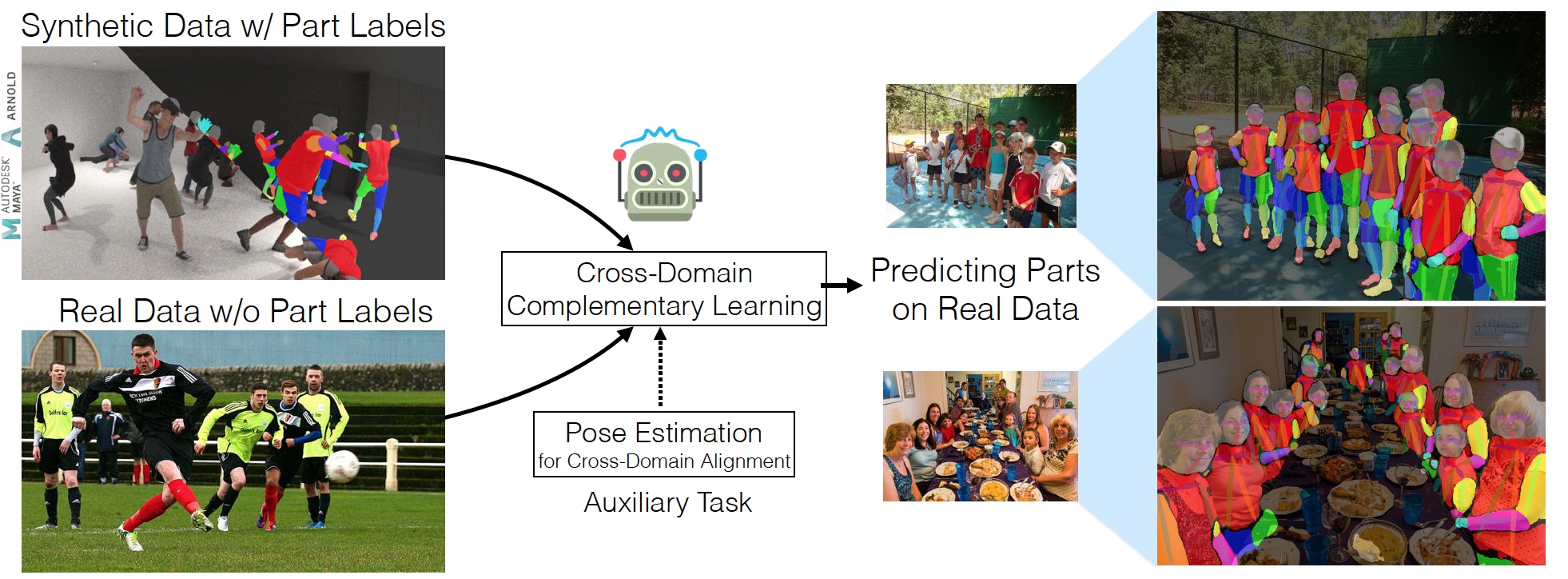kevinlin311tw / Cdcl Human Part Segmentation
Programming Languages
Projects that are alternatives of or similar to Cdcl Human Part Segmentation
CDCL
This is the code repository for the paper:
Cross-Domain Complementary Learning Using Pose for Multi-Person Part Segmentation
Kevin Lin, Lijuan Wang, Kun Luo, Yinpeng Chen, Zicheng Liu, Ming-Ting Sun
[PDF] [arXiv] [Demo Video] [ICCV2019 Demo Poster]
We address the problem of learning multi-person part segmentation without human labeling. Our proposed complementary learning technique learns a neural network model for multi-person part segmentation using a synthetic dataset and a real dataset. We observe that real and synthetic humans share a common skeleton structure. During learning, the proposed model extracts human skeletons which effectively bridges the synthetic and real domains. Without using human-annotated part segmentation labels, the resultant model works well on real world images.
Citing paper
If you find CDCL useful for your research, please consider citing:
@article{lin2020cross,
Title = {Cross-Domain Complementary Learning Using Pose for Multi-Person Part Segmentation},
Author = {Lin, Kevin and Wang, Lijuan and Luo, Kun and Chen, Yinpeng and Liu, Zicheng and Sun, Ming-Ting},
Journal = {IEEE Transactions on Circuits and Systems for Video Technology},
Year = {2020}
}
or
@article{lin2019cross,
Title = {Cross-Domain Complementary Learning with Synthetic Data for Multi-Person Part Segmentation},
Author = {Lin, Kevin and Wang, Lijuan and Luo, Kun and Chen, Yinpeng and Liu, Zicheng and Sun, Ming-Ting},
Journal = {arXiv preprint arXiv:1907.05193},
Year = {2019}
}
Installation instructions
Our codebase is developed based on Ubuntu 16.04 LTS, CUDA 9.0, CUDNN 7.0, Tensorflow 1.12.0, Keras 2.1.1.
Anaconda
We suggest creating a new conda environment for setting up the relevant dependencies. After installing Anaconda on your machine, please run the following command:
$ conda env create -f cdcl_environment.yaml
After creating the environment, you just need to activate the environment and continue running the demo code.
$ conda activate cdcl
Docker
Alternatively, we provide the Dockerfile which can be used to build a docker image with all dependencies pre-installed. You can find the Dockerfile in the folder docker. After installing Docker and Nvidia-Docker2, please go to the folder docker, and run the following command to build the docker image:
$ sudo docker build -t cdcl:v1 .
After this, you can test your docker image on your machine
$ sudo docker run --runtime=nvidia -v PathA:PathB -it cdcl:v1 bash
It is important to note that this command will mount a local folder in the docker container.
PathA is the folder path of this repo in your machine.
PathB is the target folder path in the container.
Other install solution
If Anaconda and Docker do not work well on you machine, we list the required packages as below for you to manually install the dependencies.
$ sudo apt-get -y update
$ sudo apt-get -y install libboost-all-dev libhdf5-serial-dev libzmq3-dev libopencv-dev python-opencv git vim
$ sudo pip install Cython scikit-image keras==2.1.1 configobj IPython
$ sudo apt-get -y install python-tk python3-pip python3-dev python3-tk cuda-toolkit-9-0
$ sudo pip3 install tensorflow-gpu==1.12.0
$ sudo pip3 install keras==2.1.1 Cython scikit-image pandas zmq h5py opencv-python IPython configobj cupy-cuda90
Fetch data
To run our code, you need to also fetch some additional files. Please run the following command:
$ bash fetch_data.sh
This script will fetch two pretrained neural network models. In this demo script, we provide a pretrained model, which is firstly trained on COCO2014 and our multi-person synthetic data, and then fine-tuned on PASCAL-Person-Part dataset.
This pre-trained model predcits 6 body parts in the images, and achieves 72.82% mIOU on PASCAL-Person-Part dataset. We denote this model as CDCL+PASCAL in our paper.
We also provide a pre-trained model, which predicts 15 body parts in the image. This model is trained without real data labels. We denote this model as CDCL in our paper.
Download files manually
If the script does not work well on your machine, you could manually download the pre-trained weights through the following links. Please unzip the downloaded files, and put the pre-trained weights in the folder weights
Model weights for 6 body parts: Dropbox GoogleDrive
Model weights for 15 body parts: Dropbox GoogleDrive
Run the inference code
This demo runs multi-person part segmentation on the test images. In order to run the inference code, you need to put your testing images in the folder input. Our inference code will iterate all images in the folder, and generate the results in the folder output.
We provide 2 different ways to use our inference code. Here are the example usages:
For single-scale inference, please run the following command
$ python3 inference_7parts.py --scale=1
You may also like to run the following command for multi-scale inference for more accurate results
$ python3 inference_7parts.py --scale=1 --scale=0.5 --scale=0.75
For 15 parts prediction, please run the following command
$ python3 inference_15parts.py --scale=1
Similarly, you can run the following command for multi-scale inference for more accurate results
$ python3 inference_15parts.py --scale=1 --scale=0.5 --scale=0.75
Training
The traing code is developed based on our previous repo keras-openpose-reproduce
The proposed training code and the synthetic data will be released after company approval.
Contact
Please feel free to leave suggestions or comments to Kevin Lin ([email protected]), Lijuan Wang ([email protected]), Zicheng Liu ([email protected]), Ming-Ting Sun ([email protected])


